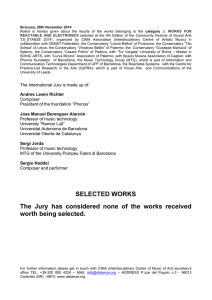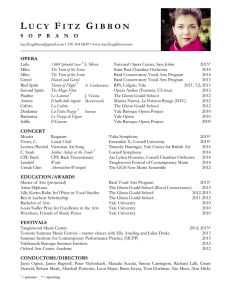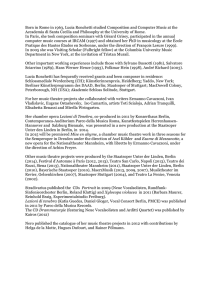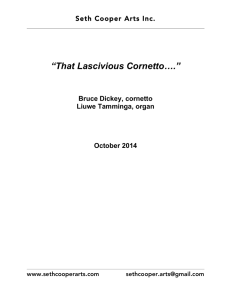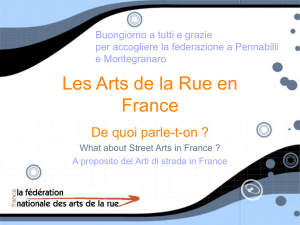ICTM STUDY GROUP FOR THE ICONOGRAPHY OF THE
advertisement
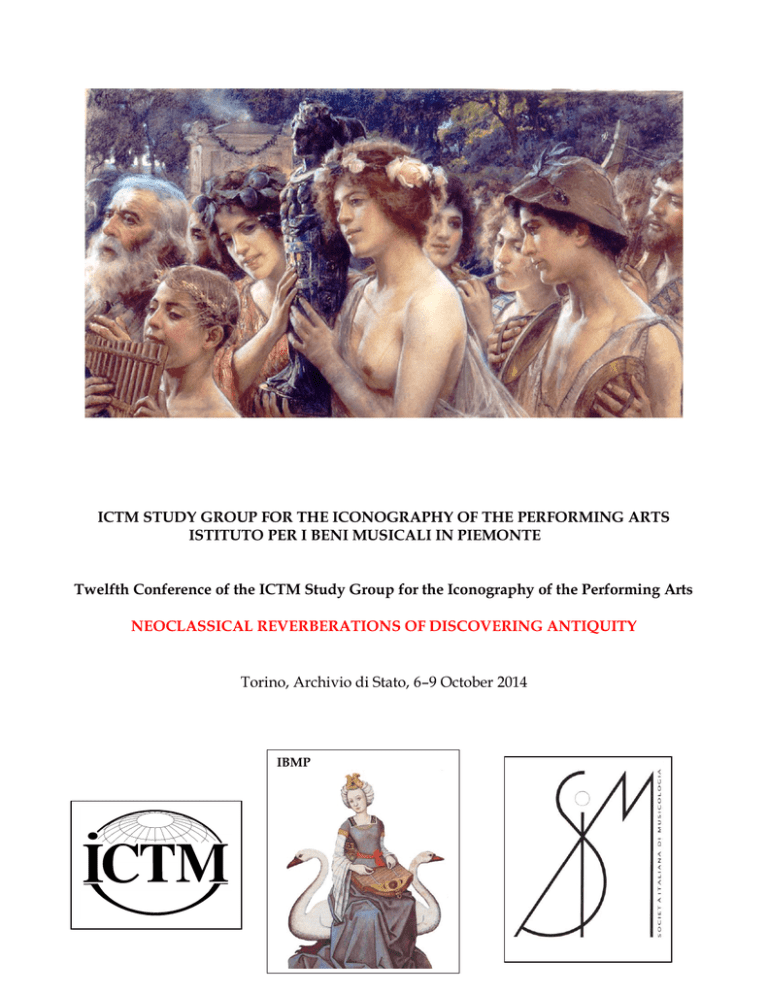
ICTM STUDY GROUP FOR THE ICONOGRAPHY OF THE PERFORMING ARTS ISTITUTO PER I BENI MUSICALI IN PIEMONTE Twelfth Conference of the ICTM Study Group for the Iconography of the Performing Arts NEOCLASSICAL REVERBERATIONS OF DISCOVERING ANTIQUITY Torino, Archivio di Stato, 6–9 October 2014 IBMP ICTM STUDY GROUP FOR THE ICONOGRAPHY OF THE PERFORMING ARTS ISTITUTO PER I BENI MUSICALI IN PIEMONTE Conference organized and program book edited by CRISTINA SANTARELLI & ZDRAVKO BLAŽEKOVIĆ Conference administrators: SABRINA SACCOMANI & VITTORIA BOVOLO The organizers acknowledge a general support by Regione Piemonte Compagnia di San Paolo Fondazione CRT Società Italiana di Musicologia Archivio di Stato di Torino Conference venue Archivio di Stato di Torino Piazzetta Mollino, 1 10124 Torino ISTITUTO PER I BENI MUSICALI IN PIEMONTE Via Anton Giulio Barrili 7 10134 Torino Tel. 0113040865 Fax 0113190277 eMail: segreteriaibmp@ibmp.it © Istituto per i Beni Musicali in Piemonte and International Council for Traditional Music The program of the conference was closed on 1 September 2014. Presentations and discussions are recorded for archival purposes. Cover image: Cesare Saccaggi, Alma Natura, ave! (1898), Torino, Galleria Civica d’Arte Moderna e Contemporanea, inv. P/502. ICTM STUDY GROUP FOR THE ICONOGRAPHY OF THE PERFORMING ARTS ISTITUTO PER I BENI MUSICALI IN PIEMONTE NEOCLASSICAL REVERBERATIONS OF DISCOVERING ANTIQUITY Twelfth Conference of the ICTM Study Group for the Iconography of the Performing Arts Torino, Archivio di Stato, 6–9 October 2014 Piazzetta Mollino, 1 10124 Torino INTRODUCTION The discovery of Herculaneum and Pompeii and their subsequent archaeological excavations influenced a renewed interest for antiquity and initiated tremendous changes at the end of the eighteenth century in the lifestyle all over Europe. Chronologically distant cultures from the millennia ago returned in new forms to the European life and refreshed its literature, theater, visual and decorative arts, music, fashion, and architecture. New methods of archaeological and historical research penetrated scholarly investigations and changed the scholarly discourse across other disciplines. It is therefore truly appropriate to return again to the topic of the European neoclassical reception of Greek, Roman and Egyptian antiquity, the references antiquity has provided in the European arts and culture through the early decades of the nineteenth century, and examine how the new aesthetics replicated the one which Europe inherited from two millennia before. It is also appropriate to examine it in Italy which not only overwhelmed the European travelers on Grand Tours with its own history, beauties and monuments, but also served for centuries as a mediator of the knowledge about the Greek culture and arts. Another reason why this conference is particularly timely is that we celebrate in this year the 250th anniversary of the publication of Winckelmann’s Geschichte der Kunst des Althertums, which appeared in Dresden in 1764. Winckelmann revolutionized the understanding of stylistic changes in GrecoRoman art and his appreciation of ancient masterpieces, repeatedly quoted in early travel books, in turn made these sculptures easier accessible to generations of travelers in Italy. But his influences reached far beyond studies of antiquity, archaeology and art history. His concept of “edle Einfalt und stille Grösse” (noble simplicity and quiet grandeur) put excessive complexities of Baroque aesthetics to the rest, and it has not passed unnoticed by Gluck in his operas, or without influence on Forkel’s understanding of the gradual evolution of stylistic changes presented in his Allgemeine Geschichte der Musik of 1788–1801. It rarely happens in an organization of any conference that individual papers provide together a balanced view of different aspects of the conference’s topic. This conference has an exceptionally homogeneous program of presentations examining the scholarly directions and artistic influences which moved neoclassical artists. A group of papers presents directions guiding scenographers in their readings of antiquity on the opera stage (Giuseppe Borsato and Francesco Bagnara in Venice, Antonio Basoli in Bologna, Alessandro Sanquirico in Milan), examines how did they understand ancient instruments (lyre built for the production of Boito’s Nerone), and analyzes Metastasio’s understanding of urban design of the Palatine Hill and Galli Bibiena’s staging of his La Clemenza di Tito. One group of papers is dedicated to reflections of antiquity in painting and sculpture (Giorgio Anselmi, Mariano Fortuny i Marsal, Lawrence Alma-Tadema, Antonio Canova, Albert Moore, JeanAuguste-Dominique Ingres), and the other to its reflections in music (Mendelssohn- Bartholdy, Verdi, Saint-Saëns, Spontini, and Strauss). Several papers are concerned with the idea of antiquity embedded in nineteenth-century architecture (Teatro Massimo in Palermo, interior and exterior decoration of buildings in Faenza, Mantua, and Lisbon) and in decorative arts (maioliche from Castelli in Abruzzo). And finally, a few examinations look into the eighteenth-century scholarly discourses concerning ancient organology, theatrical architecture, urban history of Naples, and writings on ancient history by Athanasius Kircher. It is our greatest honor to have among us at this conference two grandes dames of the research on music and theater history, each of whom in its own way made a deepest mark on the direction of research and with their work profoundly influenced our knowledge. MERCEDES VIALE FERRERO wrote countless books and articles on history of opera scenography from the seventeenth to the nineteenth century. There is hardly any historical Italian scenographer who has not found its place on pages of her writings and any Italian opera theater whose history she has not examined. ELENA FERRARI BARASSI on the other hand left her imprint with the studies of medieval organology, and even more so establishing the foundation of the research of visual sources for music in Italy. Being among the founders of the RIdIM project and for several decades its tireless promoter, she provided a methodological model of cataloguing and working with music iconography to several generations of Italian and international scholars. CRISTINA SANTARELLI Istituto per i Beni Musicali in Piemonte ZDRAVKO BLAŽEKOVIĆ ICTM Study Group on Iconography of Performing Arts Monday, 6 October 9.30 -10.00 Registration 10.00-10.30 Greetings – Opening Addresses by: Maria Barbara Bertini, Archivio di Stato di Torino Antonella Parigi, Regione Piemonte Cristina Olivetti, Compagnia di San Paolo ?, Fondazione CRT Francesco Passadore, Presidente della Società Italiana di Musicologia Zdravko Blažeković, Chair of the ICTM Study Group on Iconography of the Performing Arts Cristina Santarelli, President of the Istituto per i Beni Musicali in Piemonte FRAME SESSION – Chair: CRISTINA SANTARELLI (Istituto per i Beni Musicali in Piemonte, Torino) 10.30-11.00 CHRISTIAN GRECO (Museo Egizio, Torino), The Role played by Turin in the field of Aegyptological research 11.00-11.30 ZDRAVKO BLAŽEKOVIĆ (Research Center for Music Iconography, The Graduate Center, CUNY), Ancient Organology Before and After Herculaneum 11.00-11.30 Coffee break 12.00-12.30 PAOLA D’ALCONZO (Università “Federico II”, Napoli), Facing Antiquity―Departure and Return: Naples in the Eighteenth Century 12.30-13.00 MICHELA COSTANTINI (Torino), Common Antiquarian Interests Found in the Epistolary Exchanges between the Architect and Piedmontese Erudite Francesco Ottavio Magnocavalli and Members of the Roman Arcadia in the Middle of the Eighteenth Century: The Case of the Ancient Theater of Herculaneum FIRST SESSION: Neoclassicism in European Painting, Sculpture and Applied Arts (Part One) Chair: NICOLETTA GUIDOBALDI (Università di Bologna, Dipartimento di Beni Culturali, Ravenna) 15.00-15.30 JORDI BALLESTER GIBERT (Universitat Autònoma de Barcelona), Music and Poetics of Ancient Rome in the Work of the Spanish Painter Mariano Fortuny (1838–1874) 15.30-16.00 DANIELA CASTALDO (University of Salento, Lecce), Ancient Music in Paintings of Lawrence Alma-Tadema (1836–1912) 16.00-16.30 CRISTINA SANTARELLI (Istituto per i Beni Musicali in Piemonte, Torino), From A Musician to The Quartet: Albert Moore (1841–1893) between Classicism and Aesthetic Movement 16.30-17.00 Coffee break 17.00-17.30 ALEXANDRA VOUTYRA (Aristotle University, Thessaloniki), Ingres, Apollo, Mozart and Music 17.30-18.00 MARÍA ISABEL RODRÍGUEZ LÓPEZ (Universidad Complutense de Madrid), Chant and Enchantments: Iconography of Orpheus, from Gluck to Moreau 18.00-18.30 ELENA LE BARBIER RAMOS (Universidad de Oviedo), Ancient Musical Iconography in Neoclassical Painting Tuesday, 7 October FIRST SESSION – Neoclassicism in European Painting, Sculpture and Applied Arts (Part Two) Chair: DANIELA CASTALDO (Università del Salento, Lecce) 9.30-10.00 ANNA MARIA IOANNONI FIORE (Conservatorio Statale di Musica “L. D’Annunzio”, Pescara), Neoclassical Influences in the Depiction of Landscapes on Castelli Maioliche: The Ethical Value of Music among Myths and Ancient Ruins 10.00-10.30 NICOLETTA GUIDOBALDI (Università di Bologna Dipartimento di Beni Culturali, Ravenna), Rediscovering Antiquity and Musical Myths in Felice Giani’s Pictorial Cycles in Faenza 10.30-11.00 ESMA SULEJMANAGIĆ (Muzička akademija, Sarajevo), Music Iconography on Numismatic Products of Antiquity and the 19th Century: Antique Musical Practice and Neoclassical Musical Symbolism 11.00-11.30 Coffee break 11.30-13 Keynote speaker: ELENA BARASSI (Università di Pavia, sede di Cremona), Iconography of Iconography: Dance in Ancient Roman Representations, Canova’s Works and Reproductions in Engraving (Presentation by Zdravko Blažeković) FIRST SESSION – Neoclassicism in European Painting, Sculpture and Applied Arts (Part Three) Chair: JORDI BALLESTER GIBERT (Universitàt Autònoma de Barcelona) 15.00-15.30 LICIA MARI (Università Cattolica del Sacro Cuore, Brescia & Archivio Storico Diocesano, Mantova), Saints, Myths, Allegories in the Scenographic Frescos by Giorgio Anselmi 15.30-16.00 CARLO FIORE (Conservatorio di Musica “Vincenzo Bellini”, Palermo) & FLORIANA TESSITORE (Teatro Massimo, Palermo), The Teatro Massimo in Palermo between Modernism and Neoclassicism 16.00-16.30 LUÍS CORREIA DE SOUSA & LUZIA VALEIRO ROCHA (Centro de Estudos de Sociologia e Estética Musical, Universidade Nova de Lisboa), New Fashions, Old Models: The Antiquity Charm in Portuguese Musical Neoclassicism 16.30-17.00 Coffee break FREE PAPERS 17.00- 17.30 EMMA PETROSYAN (Institute of Archaeology and Ethnography, Armenian National Academy of Sciences, Yerevan), Music and Dance in Statues and Gemmes from Artashat 17.30-18.00 MARYAM DOLATI FARD (Tehran), The Relationship Between Text and Music in Persian Manuscripts: Ilkhanid to Safavid Era, Images of Oud Player Wednesday, 8 October SECOND SESSION: Neoclassical Attitudes in Operatic Stage (Part One) Chair: MARIA TERESA ARFINI (Università della Valle d’Aosta) 9.30-10.00 DIANA BLICHMANN (Roma), The Temple of Jupiter Statore in La Clemenza di Tito of Pietro Metastasio and Giovanni Carlo Galli Bibiena 10.00-10.30 MARIA IDA BIGGI (Fondazione Cini / Università “Ca’ Foscari”, Venezia), Borsato, Bagnara and Basoli: Archaelogical References and Reverberations on the Venetian and Bolognese Neoclassical Stage 10.30-11.00 GABRIELLA OLIVERO (Torino), The “New” Babylon by Alessandro Sanquirico 11.00-11.30 Coffee break 11.30-13.00 Keynote speaker: MERCEDES VIALE FERRERO (Torino), The Last Day of Pompeii as Imagined by Alessandro Sanquirico, or: How to Rebuild Pompeii in Order to Destroy It (Presentation by Maria Ida Biggi) SECOND SESSION: Neoclassical Attitudes in Operatic Stage (Part Two) Chair: MARIA IDA BIGGI (Fondazione Cini /Università Ca’ Foscari, Venezia) 15.00-15.30 INNA NARODITSKAYA (Northwestern University), Elizaveta of Russia – a Euro-Asian Princess and Heir of Roman Augustus: A Spectacle of Coronation and Imperial Opera 15.30-16.00 DARIO DE CICCO (Conservatorio Statale di Musica “Giuseppe Verdi”, Torino / Université de Genève), Verdi and the Egyptian Culture between Anegdots, Epistolar Sources and Imagination 16.00-16.30 Coffee break 16.30-17.00 DONATELLA MELINI (Fondazione “Antonio Carlo Monzino”, Milano), “Or che i Numi son vinti, a me la cetra, A me l’altar!”: Stories and Iconographies about the Lyra Made for Arrigo Boito’s Nerone 17.00-17.30 TIMOTHY S. FLYNN (Olivet College, Mich.), Classical Reverberations in the Music and Life of Camille Saint-Saëns (1835–1921) Thursday 9 October SECOND SESSION: Neoclassical Attitudes in Operatic Stage (Part Three) Chair: JORDI BALLESTER GIBERT (Universitàt Autònoma de Barcelona) 9.30 -10.00 SANNA IITTI (Hyvinkää, Finland), Heroism in Gasparo Spontini’s Opera La Vestale 10.00-10.30 MARIA TERESA ARFINI (Università della Valle d’Aosta), Around Antigone: Reflections on Iconography and Music in the German Revival of the Classical Tragedy 10.30-11.00 MAIA SIGUA (Tbilisi State Conservatory), The Concept of Tragedy after Aristotle and Daphne by Richard Strauss 11.00-11.30 Coffee break THIRD SESSION: Antiquaria: Documents and Testimonies through the Ages Chair: MARIA TERESA ARFINI (Università della Valle d’Aosta) 11.30-12.00 JOHN Z. MCKAY (University of South Carolina, School of Music), Roles for Musical Curiosities in Kircher’s Antiquarian Visions 12.00-12.30 STEFANIA MACIOCE (Università “La Sapienza”, Roma), Apollo: Figurative Variations of a Neoclassical Ideal 12.30-13.00 FRANCESCA CANNELLA (Università del Salento, Lecce), «Gli eroi della storia favolosa e le invenzioni per essi nobilitate»: The Myth of the Argonauts between Musical Iconography and Literary Invention of the Modern Age FOURTH SESSION: Musical impressions from ‘Grand Tour’ Chair: ALEXANDRA VOUTYRA (Aristotle University, Thessaloniki) 15.00-15.30 SIEGWART REICHWALD (Petrie School of Music, Converse College, Spartanburg, S.C.), Eyes Wide Open: The Compositional Impact of Mendelssohn’s Artistic and Religious Grand Tour Experiences 15.30-16.00 SYLVAIN PERROT (French School at Athens), Musical Impressions in Views of Greece during the 19th Century 16.00-16.30 MARÍA JESÚS FERNÁNDEZ SINDE (Universidad Complutense de Madrid), Music Dreaming: Iconographic Sources from Spanish Painters―Recreation of Identities and Grand Tours 16.30-17.00 Coffee break 17.00 Closing Session
